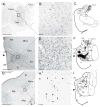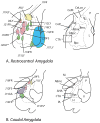Amygdala projections to the lateral bed nucleus of the stria terminalis in the macaque: comparison with ventral striatal afferents
- PMID: 23696521
- PMCID: PMC3729860
- DOI: 10.1002/cne.23340
Amygdala projections to the lateral bed nucleus of the stria terminalis in the macaque: comparison with ventral striatal afferents
Abstract
The lateral bed nucleus of the stria terminalis (BSTL) is involved in mediating anxiety-related behaviors to sustained aversive stimuli. The BSTL forms part of the central extended amygdala, a continuum composed of the BSTL, the amygdala central nucleus, and cell columns running between the two. The central subdivision (BSTLcn) and the juxtacapsular subdivision (BSTLJ) are two BSTL regions that lie above the anterior commissure, near the ventral striatum. The amygdala, a heterogeneous structure that encodes emotional salience, projects to both the BSTL and ventral striatum. We placed small injections of retrograde tracers into the BSTL, focusing on the BSTLcn and BSTLJ, and analyzed the distribution of labeled cells in amygdala subregions. We compared this to the pattern of labeled cells following injections into the ventral striatum. All retrograde results were confirmed by anterograde studies. We found that the BSTLcn receives stronger amygdala inputs relative to the BSTLJ. Furthermore, the BSTLcn is defined by inputs from the corticoamygdaloid transition area and central nucleus, while the BSTLJ receives inputs mainly from the magnocellular accessory basal and basal nucleus. In the ventral striatum, the dorsomedial shell receives inputs that are similar, but not identical, to inputs to the BSTLcn. In contrast, amygdala projections to the ventral shell/core are similar to projections to the BSTLJ. These findings indicate that the BSTLcn and BSTLJ receive distinct amygdala afferent inputs and that the dorsomedial shell is a transition zone with the BSTLcn, while the ventral shell/core are transition zones with the BSTLJ.
Keywords: amygdalopiriform transition area; anxiety; corticoamygdaloid transition region; dorsomedial shell; extended amygdala; juxtacapsular; oval.
© 2013 Wiley Periodicals, Inc.
Conflict of interest statement
CONFLICT OF INTEREST
The authors declare no conflict of interest.
Figures












Similar articles
-
Afferent connections of the interstitial nucleus of the posterior limb of the anterior commissure and adjacent amygdalostriatal transition area in the rat.Neuroscience. 1999;94(4):1097-123. doi: 10.1016/s0306-4522(99)90280-4. Neuroscience. 1999. PMID: 10625051
-
Amygdaloid projections to ventromedial striatal subterritories in the primate.Neuroscience. 2002;110(2):257-75. doi: 10.1016/s0306-4522(01)00546-2. Neuroscience. 2002. PMID: 11958868
-
Bed nucleus of the stria terminalis and extended amygdala inputs to dopamine subpopulations in primates.Neuroscience. 2001;104(3):807-27. doi: 10.1016/s0306-4522(01)00112-9. Neuroscience. 2001. PMID: 11440812
-
Cortical afferents to the extended amygdala.Ann N Y Acad Sci. 1999 Jun 29;877:309-38. doi: 10.1111/j.1749-6632.1999.tb09275.x. Ann N Y Acad Sci. 1999. PMID: 10415657 Review.
-
Convergence and segregation of ventral striatal inputs and outputs.Ann N Y Acad Sci. 1999 Jun 29;877:49-63. doi: 10.1111/j.1749-6632.1999.tb09260.x. Ann N Y Acad Sci. 1999. PMID: 10415642 Review.
Cited by
-
Blockade of glutamatergic transmission in the primate basolateral amygdala suppresses active behavior without altering social interaction.Behav Neurosci. 2017 Apr;131(2):192-200. doi: 10.1037/bne0000187. Epub 2017 Feb 20. Behav Neurosci. 2017. PMID: 28221080 Free PMC article.
-
The Subcortical Atlas of the Marmoset ("SAM") monkey based on high-resolution MRI and histology.Cereb Cortex. 2024 Apr 1;34(4):bhae120. doi: 10.1093/cercor/bhae120. Cereb Cortex. 2024. PMID: 38647221 Free PMC article.
-
Bed nucleus of the stria terminalis regulates fear to unpredictable threat signals.Elife. 2019 Apr 4;8:e46525. doi: 10.7554/eLife.46525. Elife. 2019. PMID: 30946011 Free PMC article.
-
Abundant collateralization of temporal lobe projections to the accumbens, bed nucleus of stria terminalis, central amygdala and lateral septum.Brain Struct Funct. 2017 May;222(4):1971-1988. doi: 10.1007/s00429-016-1321-y. Epub 2016 Oct 4. Brain Struct Funct. 2017. PMID: 27704219 Free PMC article.
-
Neuropeptide regulation of signaling and behavior in the BNST.Mol Cells. 2015 Jan 31;38(1):1-13. doi: 10.14348/molcells.2015.2261. Epub 2014 Dec 4. Mol Cells. 2015. PMID: 25475545 Free PMC article. Review.
References
-
- Aggleton JP, Friedman DP, Mishkin M. A comparison between the connections of the amygdala and hippocampus with the basal forebrain in the macaque. Exp Brain Res. 1987;67(3):556–568. - PubMed
-
- Aggleton JP, Mishkin M. Projections of the amygdala to the thalamus in the cynomolgus monkey. J Comp Neurol. 1984;222:56–68. - PubMed
-
- Alheid GF, DeOlmos CA, Beltramino CA. Amygdala and extended amygdala. In: Paxinos G, editor. The Rat Nervous System. San Diego: Academic Press; 1995. pp. 495–578.
-
- Alheid GF, Heimer L. New perspectives in basal forebrain organization of special relevance for neuropsychiatric disorders: the striatopallidal, amygdaloid, and corticopetal components of substantia innominata. Neuroscience. 1988;27:1–39. - PubMed
Publication types
MeSH terms
Substances
Grants and funding
LinkOut - more resources
Full Text Sources
Other Literature Sources

